|
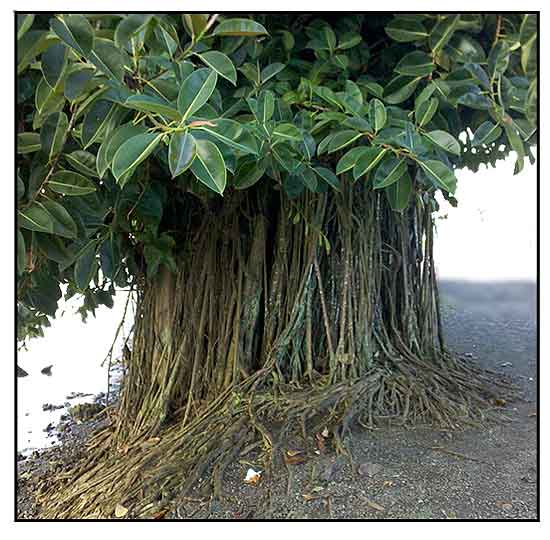 General info General info
- Ficus elastica, the rubber fig, rubber bush, rubber tree, rubber plant, rubber bush, is a species of flowering plant in the family Moraceae.
- Despite the
overuse of "rubber" in its common names, it is not used in the commercial production of natural rubber.
- F. elastica yields a milky latex, separate from the sap and stored in different cells. Although the latex was once used to make rubber, it should not be confused with Pará rubber tree (Hevea brasiliensis), the main commercial source of latex for rubber making. (23)
Botany
• Ficus elastica is a glabrous spreading tree, up
to 10 meters high, normally starting as an epiphyte, sending down numerous adventitious roots from the trunk
and larger branches. Leaves are very leathery, smooth and shining, elliptic-oblong, 15 to 25 centimeters long, the tip with a tapering point and entire margin. Stipules are deciduous, membranaceous, and usually
red, often as long as the leaves. Receptacles are axillary, usually in pairs, stalkless, smooth, greenish-yellow, oblong-ovoid, about 1 centimeter long.
 • It is a large tree in the banyan group of figs, growing to 30–40 m (100–130 ft) – rarely up to 60 m or 195 ft – tall, with a stout trunk up to 2 m (6 ft 7 in) in diameter. Trunk develops aerial and buttressing roots to anchor it in the soil and help support heavy branches. Leaves are broad, shiny and oval, 10–35 cm (4–14 in) long and 5–15 cm (2–6 in) broad; leaf size is largest on young plants (occasionally to 45 cm or 17+1â„2 in long), much smaller on old trees (typically 10 cm or 4 in long). Leaves eaves develop inside a sheath at the apical meristerm, which grows larger as the new leaf develops. When it is mature, it unfurls and the sheath drops off the plant. Inside the new leaf, another immature leaf is waiting to develop. (23) • It is a large tree in the banyan group of figs, growing to 30–40 m (100–130 ft) – rarely up to 60 m or 195 ft – tall, with a stout trunk up to 2 m (6 ft 7 in) in diameter. Trunk develops aerial and buttressing roots to anchor it in the soil and help support heavy branches. Leaves are broad, shiny and oval, 10–35 cm (4–14 in) long and 5–15 cm (2–6 in) broad; leaf size is largest on young plants (occasionally to 45 cm or 17+1â„2 in long), much smaller on old trees (typically 10 cm or 4 in long). Leaves eaves develop inside a sheath at the apical meristerm, which grows larger as the new leaf develops. When it is mature, it unfurls and the sheath drops off the plant. Inside the new leaf, another immature leaf is waiting to develop. (23)
Distribution
- Introduced, but now pantropic
in cultivation.
- Popularly planted in parks and as a roadside tree.
- Cultivated as a potted plant by florists.
- Native to Assam, Bangladesh, China, East Himalaya, Jawa, Laos, Malaya, Myanmar, Nepal, Sumatera, Thailand, Vietnam. (15)
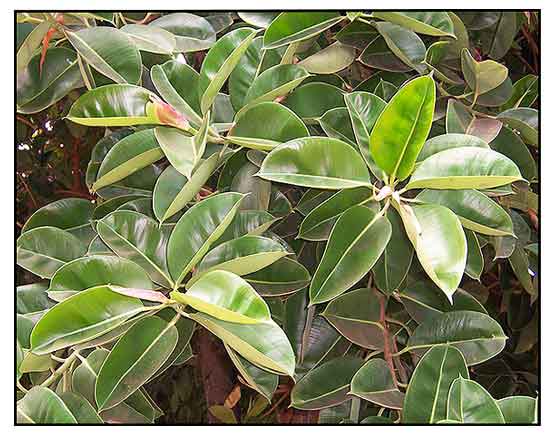 Constituents Constituents
- The latex contains caotuchouc, 10-30%; resin, 1.58%; a bitter substance; albuminoid; and magnesium salts. Wax contains cerotic acid.
- Leaves yielded four compounds: emodin, sucrose, morin and rutrin. (6)
- Leaves yielded two new compounds, ficuselastic acid and (1'S,6'R)-8-O-β-D- glucopyranosyl abscisate sodium, along with 12 known compounds: feroxidin, quercitrin, kaempferin, myricitrin, syringin, citroside B, corchoionoside C, (6S,9R)- roseoside, oleanolic acid, ursolic acid, benzyl O-β-D-glucopyranoside, icariside F2. (11)
- Bark of aerial roots yielded
three compounds, ficusamide (1), ficusoside (2) and elasticoside (3), together with nine known compounds, including four triterpenes, three steroids and two aliphatic linear alcohols. (see study below) (12)
- Chromato-mass spectrometry study for composition of raw materials of leaves of Ficus elastica identified 68 compounds. Maximum amount was accounted for б-D-Glucopyranoside, methyl (28,99%), Phytol (9,90%), 2-Hydroxy-3-methylsuccinic acid (6,93%), Lanosterol (6,13%), Hydroquinone (5,55%), 9,12,15-Octadecatrienoic acid, ethyl ester, (Z,Z,Z)- (4,86%), Lup-20(29)-en-3- one (4,17%), 1,2-Benzenediol (3,33%), Lupeol (2,95%), 16-Allopregnene-3б,9а-diol-20-one 3-O-acetate (2,77%), 9-Octadecenamide, (Z)- (2,67%), 9,12,15-Octadecatrienoic acid, (Z,Z,Z)- (2,05%), з-Sitosterol (1,84%), а-d-Lyxofuranoside, methyl (1,57%), Dasycarpidan-1-methanol, acetate (ester) (1,52%), n-Hexadecanoic acid (1,45%), Hexadecanoic acid, ethyl ester (1,33%), 1,8-Dioxacyclohexadecane-2,10- dione, 5,6:12,13-diepoxy-8,16-dimethyl- (1,15%), Vitamin E (0,64%). (20)
- Qualitative analysis of methanol extract of leaves
yielded carbohydrates, proteins, amino acids, steroids, glycosides, flavonoids, alkaloids, tannins, saponins and terpenoids. Carbohydrates, steroids, tannins were present in higher amounts; proteins, flavonoids, alkaloids, saponins, terpenoids in moderate amounts; and amino acids and glycosides in lesser amount. (see study below) (21)
- Phytochemical screening of methanolic extract of stem bark yielded alkaloids, flavonoids, phenolics, saponins, glycosides, terpenoids, and eugenols, with absence of steroids. (see study below) (24)
- Study of bark of aerial roots isolated three new compounds, namely: elasticamide, elastiquinone, and fucusoside B, along with four known compounds. (see study below) (25)
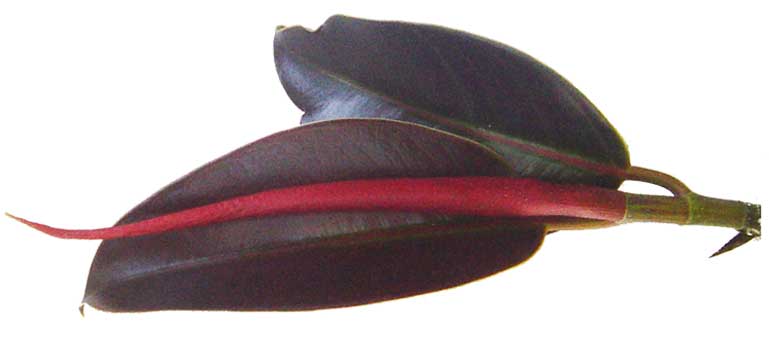 Properties Properties
- Astringent, vulnerary, styptic.
- The latex is irritant to the eyes and skin, and toxic if taken internally. (23)
- Studies
have suggested anti-inflammatory, hypoallergenic, antimicrobial, anthelmintic, antitumor, antioxidant, analgesic, antimalarial, antitrypanosomal properties.
Parts utilized
Rootlets, bark, latex.
Uses
Edibility
- In Java, the very young leaf-tips, before the leaves expand, are eaten as salad.
Folkloric
- In the Philippines, decoction of aerial rootlets used as vulnerary for wounds, dermatitis, cuts, and sores.
-
Skin eruptions and dermatitis: Boil
one cup of chopped bark in 1/2 gallon of water for 10 mins; use decoction
to wash involved areas, twice daily.
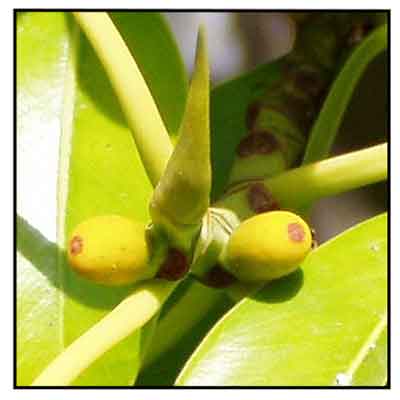 - Decoction of aerial rootlets used for wounds, cuts and sores. - Decoction of aerial rootlets used for wounds, cuts and sores.
- Bark is astringent and used as styptics for wounds.
- In Panama, latex used for parasitic worms (Trichuris trichura).
- In northern Cameroon,
used as fertility enhancement.
- In West Africa, used in the treatment of muscle and joint pain. (2)
- Used as diuretic.
- Used for treatment of eczema, tinea, leprosy, and boils.
- Used for treatment of hypertension and diabetes.
Plant that Detoxify the
Air
- Of the ficus plants tested, the rubber
plant is considered the best for removing chemical toxins from the indoor environment,
especially formaldehyde. (1)
Others
- Latex: Latex used for various applications of natural rubber, i.e., tires, car components, machines parts, footwear, toys, etc. (18)
- Bark: Fibrous bark used in the manufacture of clothes and rope. (18)
- Wood: Although of poor quality, used for boards, posts, fuel. (18)
Superstition
- Folklore advises against
having it as a decorative bonzai inside the house as it is believed
to invite ghosts.
 Studies Studies
• Anti-Inflammatory:
Study evaluated the anti-inflammatory activity of an aqueous extract of F. elastica in carrageenan-induced edema and adjuvant-induced arthritis in rats. Results showed marked inhibition of experimentally induced inflammation in the two test models,
similar to those achieved with indomethacin, an effect attributed to
the presence of flavonoids. (2)
• Hypoallergenicity:
(1) Ficus elastica has been suggested as a possible source of natural
rubber latex without the allergenicity of latex protein from Hevea brasiliensis.
(2) Preliminary studies showed that natural rubber from Ficus elastica do
not cause allergic reactions in hypersensitive humans
• Antimicrobial / Constituents:
Study isolated four known compounds from the leaves of F elastica – emodin, sucrose, morin and rutrin. Results showed antimicrobial activity against B cereus and Pseudomonas aeruginosa. No Antifungal activity was observed. (6)
• Anthelmintic / Latex:
Study of F. religiosa, F. elastica and F. bengalensis showed the three plants possess anthelmintic activity against Indian earthworm Pheretima posthuma. Results showed F. religiosa showed more activity than the other two. (7)
• Anthelmintic / Leaves:
Study evaluated the anthelmintic activity of methanol and ethanol extract of leaves against Indian earthworm Pheritima posthuma. Metronidazole was the reference drug. (9)
• Antitumor / Antioxidant:
Methanolic extract of leaves and branches showed DPPH scavenging activity. Activity was attributed possibly to its rich content of polyphenolic compounds and flavonoids. A petroleum ether fraction and dichloromethane fraction showed activity against liver and breast human tumor cell line. (10)
• Constituents / Antioxidant:
Leaves yielded two new compounds, ficuselastic acid and (1'S,6'R)-8-O-β-D- glucopyranosyl abscisate sodium, along with 12 known compounds. Compounds 1 and 2 showed significant antioxidant activity, while 4 and 5 showed meaningful reducing capacity. Three flavonoids, 3-5, showed potent antioxidant activity. (11)
• Ficusamide and Elastocide / Cytotoxicity / Antibacterial:
Bark of aerial roots yielded three compounds, ficusamide, ficusoside, and elasticoside, together with nine known compounds, including four triterpenes, three steroids, and two alipathic linear alcohols. Ficusamide showed cytotoxicity against human cancer cell lines and strong activity against Staph saprophyticus. Elastocide showed potent activity against Enterococcus faecalis. (12)
• Anti-Inflammatory / Roots: Study evaluated an aqueous extract of Ficus elastica for anti-inflammatory effect in a carrageenan-induced edema and adjuvant-induced arthritis models in rat. Results showed orally administered extract significantly inhibited experimentally induced inflammation in the two models. Effect was similar to indomethacin. The activity was attributed to the presence of a pigment of the flavonoid class. (14)
• Silver Nanoparticles / Leaves: Study reports on the green synthesis of silver nanoparticles using leaf extract of F. elastica and alternative energy source of microwave irradiation. The study provides new direction for developing a catalytic tube for controlling air pollution SO2 caused by petrol-driven vehicles. (16)
• Anti-Inflammatory / Analgesic / Stem Bark: Study of methanolic extract of stem bark of Ficus elastica showed significant (p<0.05) inhibition of carrageenan induced inflammation and acetic acid induced writhing in a rat model. (17)
• Antimalarial / Antitrypanosomal / Cytotoxicity / Aerial Roots: Study of methanol extract of roots of Ficus elastica at 25 µg/ml plasmodiacidal activity (IC50 9.5 µg/mL) against Plasmodium falciparum and trypanocidal activity (IC50 0.9 µg/ml) against Trypanosoma brucei brucei. It showed low cytotoxic effect on HeLa cancer cell line. Chloroquine was used as reference drug with IC50 7.9 nM. (19)
• Larvicidal against Culex spp. / Leaves: Study evaluated a methanol leaf extract of Ficus elastica for larvicidal activity against Culex sp. The methanol extract showed high percentage of mortality against mosquito larvae: 46.66% in 1 ml after two and three days, and 56.66%, 96.66%, and 100% mortality rate in 2 ml, 3 ml, and 4 ml concentration respectively. The high rate of larvicidal activity was attributed to the large amount of phytochemicals in F. elastica. (see constituents above) (21)
• Antidepressant / Leaves: Study evaluated the antidepressant activity of various extracts of leaves of Ficus elastica in two models: Forced swim test (FST) and Tail suspension test (TST).The methanolic extract was found most active. In both FST and TST, the methanol extract at 500- mg/kg produced significant (p<0.05) reduction in immobility period. Activity was attributed to the presence of flavonoids. (22)
• Antimalarial / Stem Bark: Study of evaluated methanol extract of stem bark of F. elastica for antimalarial potential against Plasmodium berghei strain ANKA (PbANKA). Prophylactic study showed dose-related increase in antimalarial activity, with the 400 mg/kg dose showing best potency, bested only by 10 mg/kg Chloroquine. Curative study showed significant inhibition when dosage was increased from 100 mg/kg to 200 mg/kg, with insignificant change at 400 mg/kg. Acute toxicity study showed no mortality or toxic effects even at dose of 1000 mg/kg. Results showed oral administration of crude extracts of stem bark showed significant antimalarial activity in P. berghei-infected mice and showed low cytotoxicity. Results suggest higher prophylactic than curative activity. (see constituents above) (24)
• Anticancer / Antiproliferative / Bark and Wood of Aerial Roots: Study of evaluated the anticancer activity of bark and wood extracts of Ficus elastica aerial roots. Three new compounds were isolated from the bark of aerial roots, namely: elasticamide, elastiquinone, and fucusoside B. Colorimetric MTT assay evaluated the compounds for anti-proliferative effect on six human cancer cell lines. Elastiquinone showed most significant cytotoxic activity with IC50 14 µM against B16F10 melanoma cells. Peracetylated for of ficusoside B displayed lowest IC50 (11 µM) against U373n glioma cell lines. Results suggest a potential source of new compounds with antiproliferative activity. (25)
Availability
- Wild-crafted.
- Cultivated.
|


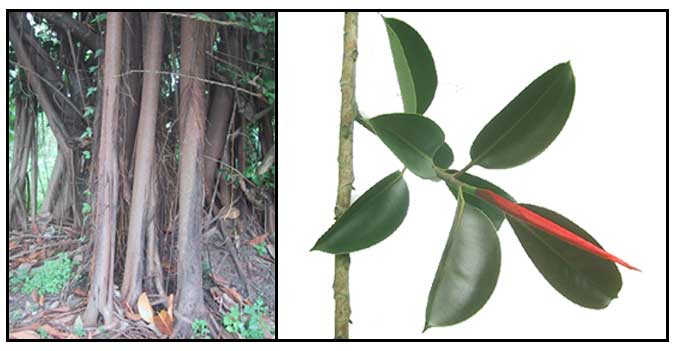
![]()

